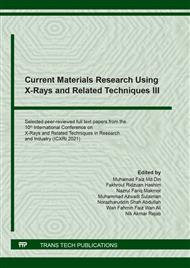[1]
K. Nahar, M. K. Hossain, and T. A. Khan, Alginate and its versatile application in drug delivery, Journal of Pharmaceutical Sciences and Research, 9 (2017) 606.
Google Scholar
[2]
Y. Murata, Y. Kodama, T. Isobe, K. Kofuji, and S. Kawashima, Drug release profile from calcium-induced alginate-phosphate composite gel beads, International Journal of Polymer Science, 2009 (2009).
DOI: 10.1155/2009/729057
Google Scholar
[3]
K. Y. Lee and D. J. Mooney, Alginate: properties and biomedical applications, Progress in polymer science, 37 (2012) 106-126.
DOI: 10.1016/j.progpolymsci.2011.06.003
Google Scholar
[4]
M. J. Cardoso, R. R. Costa, and J. F. Mano, Marine origin polysaccharides in drug delivery systems, Marine drugs, 14 (2016) 34.
DOI: 10.3390/md14020034
Google Scholar
[5]
A. Tripathi and J. S. Melo, Advances in biomaterials for biomedical applications, Springer. (2017).
Google Scholar
[6]
F. Wang, S. He, and B. Chen, Retinoic acid-loaded alginate microspheres as a slow release drug delivery carrier for intravitreal treatment, Biomedicine and Pharmacotherapy, 97 (2018) 722-728.
DOI: 10.1016/j.biopha.2017.10.109
Google Scholar
[7]
A. Raha, S. Bhattacharjee, P. Mukherjee, M. Paul, and A. Bagchi, Design and characterization of ibuprofen loaded alginate microspheres prepared by ionic gelation method, Int J Pharma Res Health Sci, 6 (2018) 2713-16.
Google Scholar
[8]
D. M. Hariyadi, N. Rosita, and T. J. Rosadi, Effect of total amount of metformin HCl on the characteristics of metformin-ca alginate microspheres, Jurnal Farmasi dan Ilmu Kefarmasian Indonesia, 5 (2018) 13-19.
DOI: 10.20473/jfiki.v5i12018.13-19
Google Scholar
[9]
S. Braim, K. Śpiewak, M. Brindell, D. Heeg, C. Alexander, and T. Monaghan, Lactoferrin-loaded alginate microparticles to target Clostridioides difficile infection, Journal of pharmaceutical sciences, 108 (2019) 2438-2446.
DOI: 10.1016/j.xphs.2019.02.025
Google Scholar
[10]
H. Mohamed, S. Mustafa, A. Fitrianto, and Y. A. Manap, Development of alginate–gum arabic beads for targeted delivery of protein, SMU Med J, 3 (2016) 486-508.
Google Scholar
[11]
J. N. Etter, M. Karasinski, J. Ware, and R. A. J. J. o. M. S. M. i. M. Oldinski, Dual-crosslinked homogeneous alginate microspheres for mesenchymal stem cell encapsulation, Journal of Materials Science: Materials in Medicine, 29 (2018) 1-10.
DOI: 10.1007/s10856-018-6151-4
Google Scholar
[12]
R. Iswandana, K. S. S. Putri, F. R. Wulandari, G. Najuda, S. P. Sari, and J. Djajadisastra, Preparation of calcium alginate-tetrandrine beads using ionic gelation method as colon-targeted dosage form, Journal of Applied Pharmaceutical Science, 8 (2018) 068-074.
DOI: 10.7324/japs.2018.8509
Google Scholar
[13]
K. V. R. Reddy and M. V. Nagabhushanam, Process and parameters affecting drug release performance of prepared cross-linked alginate hydrogel beads for ezetimibe, International Journal of Pharmacy and Pharmaceutical Sciences, 9 (2017) 254-262.
DOI: 10.22159/ijpps.2017v9i2.16235
Google Scholar
[14]
K. Midha, M. Nagpal, and S. Arora, Microspheres: a recent update, Int. J. Recent. Sci. Res., l, (2015) 5859-67.
Google Scholar
[15]
A. Sailaja and K. Anusha, Review on microspheres as a drug delivery carrier, International Journal of Advances in Pharmaceutics, 6 (2017) 96-102.
Google Scholar
[16]
M. Ye, S. Kim, and K. Park, Issues in long-term protein delivery using biodegradable microparticles, J Control Release, 146 (2010) 241-60.
DOI: 10.1016/j.jconrel.2010.05.011
Google Scholar
[17]
V. C. Patole and A. P. Pandit, Mesalamine-loaded alginate microspheres filled in enteric coated HPMC capsules for local treatment of ulcerative colitis: In vitro and in vivo characterization, Journal of Pharmaceutical Investigation, 48 (2018) 257-267.
DOI: 10.1007/s40005-017-0304-1
Google Scholar
[18]
S. Gedam, P. Jadhav, S. Talele, and A. Jadhav, Effect of crosslinking agent on development of gastroretentive mucoadhesive microspheres of risedronate sodium, International Journal of Applied Pharmaceutics, 10 (2018) 133-140.
DOI: 10.22159/ijap.2018v10i4.26071
Google Scholar
[19]
P. Zhai, X. Chen, and D. J. Schreyer, Preparation and characterization of alginate microspheres for sustained protein delivery within tissue scaffolds, Biofabrication, 5 (2013) 015009.
DOI: 10.1088/1758-5082/5/1/015009
Google Scholar
[20]
S. Shukla, D. Jain, and K. Verma, Formulation and in vitro characterization of alginate microspheres loaded with diloxanide furoate for colon-specific drug delivery, Asian Journal of Pharmaceutics : Free full text articles from Asian J Pharm, 4 (2014).
DOI: 10.4103/0973-8398.76742
Google Scholar
[21]
M. M. Ahmed, S. Abd El-Rasoul, S. H. Auda, and M. A. Ibrahim, Emulsification/internal gelation as a method for preparation of diclofenac sodium–sodium alginate microparticles, Saudi Pharmaceutical Journal, 21 (2013) 61-69.
DOI: 10.1016/j.jsps.2011.08.004
Google Scholar
[22]
F. Razak, V. Chyzna, N. Morris, A. Murphy, and J. Kennedy, An investigation into the effects of pH and material concentration on the morphology of Chitosan-Alginate microspheres prepared using an Ionic gelation techniques, International Journal of Advance Scientific Research and Management, 2 (2017) 13-24.
Google Scholar
[23]
X. H. Yong, M. I. Mazlam, and N. Ahmad, Fabrication and characterization of porous biphasic β-tricalcium phosphate/carbonate apatite alginate coated scaffolds, Ceramics International, 44 (2018) 9499-9505.
DOI: 10.1016/j.ceramint.2018.02.168
Google Scholar
[24]
A. R. Cho, Y. G. Chun, B. K. Kim, and D. J. Park, Preparation of alginate–CaCl2 microspheres as resveratrol carriers, Journal of Materials Science, 49 (2014) 4612-4619.
DOI: 10.1007/s10853-014-8163-x
Google Scholar


